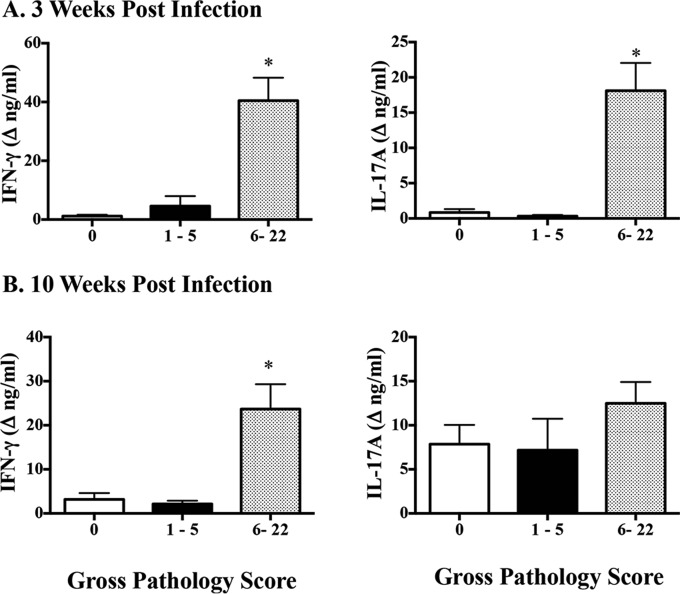FIG 7.
Association of ESAT-6:CFP10-specific IFN-γ and IL-17A responses with lesion severity (i.e., gross pathology scores) in the 2014 vaccine efficacy study. Treatment groups included nonvaccinated animals, BCG-vaccinated animals, and animals vaccinated with BCG mutants (i.e., BCG Δfdr8, BCG ΔleuCD Δpks16, BCG ΔmetA, and BCG ΔmmaA4). Virulent M. bovis strain 10-7428 was administered by aerosol to all calves 3.5 months after vaccination, and calves were euthanized 4.5 months after M. bovis challenge (Table 1). Whole blood from all calves was collected into heparinized tubes at 2.5 and 10 weeks after challenge and stimulated with 1 μg/ml rESAT-6:CFP10 or medium alone (no stimulation) for 16 h at 39°C, and plasma was harvested for IFN-γ and IL-17A analyses using ELISA kits (Bovigam [Prionics Ag] and bovine IL-17A ELISA VetSet [Kingfisher Biotech]). The lesion severity for lungs and lymph nodes (i.e., mediastinal and tracheobronchial lymph nodes) was determined using a semiquantitative scoring system adapted from that described by Vordermeier et al. (24). Groups were split based on gross pathology scores of 0 (n = 12; all vaccinated animals), 1 to 5 (n = 7; all vaccinated animals), or 6 to 22 (n = 10; all nonvaccinated animals). Data (mean ± SEM) are presented as IFN-γ (left) and IL-17A (right) responses (changes in nanograms per milliliter, i.e., antigen stimulation minus medium alone) to rESAT-6:CFP10 at 3 weeks after M. bovis challenge (A) and 10 weeks after M. bovis challenge (B), as related to gross pathology scores determined at necropsy 4.5 months after challenge. Similar results were obtained for responses to M. bovis PPD (data not shown). *, response differs from the other responses in the graph (P < 0.05, ANOVA followed by Tukey's multiple-comparison test).

